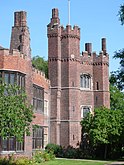Gainsborough Old Hall
Gainsborough Old Hall is a manor house in Gainsborough in the English county of Lincolnshire . It is over 500 years old and is one of the best preserved medieval mansions in England.
Sir Thomas Burgh had the house built in 1460. The Burghs were rich and powerful people. Gainsborough Old Hall was not only their family home, but also demonstrated their wealth and importance. Sir Thomas was a great benefactor of Newark Church and also founded the Chantry and Alms House (English: church poor house) in Gainsborough. In 1470 the mansion was attacked by Sir Robert Welles after a dispute over land, social status and honor, but not badly damaged. In 1484 King Richard III was guest of Sir Thomas.
In 1510, Sir Thomas Burgh's son, Edward , was imprisoned at Gainsborough Old Hall after he was declared insane. Sir Edward died in 1528 and his eldest son, Sir Thomas , became head of the family. In 1529 his son and heir, Sir Edward, married Catherine Parr , who later became the sixth wife of Henry VIII . The couple stayed at Gainsborough Old Hall until 1530, when they got their own mansion at Kirton-in-Lindsay .
King Henry VIII visited Gainsborough Old Hall twice, once in 1509 and then again in 1541 with Queen Catherine Howard . The Queen was accused of indiscretions at both Gainsborough and Lincoln and was executed. Catherine Parr, who was already a widow at the time, became Henry's sixth wife.
After Thomas, the 5th Baron Burgh, died without an heir, the mansion was sold in 1596 to William Hickman , a London merchant who had many improvements made to the house, particularly the east wing. William and his mother, Rose , supported John Smyth and the Baptist movement . They allowed them to meet at Gainsborough Old Hall from 1603 until they fled to Holland . The Hickman family continued to play an important role in the development of Gainsborough and many family members became MPs for Gainsborough. Sir Neville Hickman invited John Wesley to preach in the Great Hall several times, in 1759, 1761, and 1764.
In 1720 a new house was built in Thonock on the outskirts and Gainsborough Old Hall lost its family seat status. The manor house was now uninhabited, but remained in the family's possession and was used for various events.
The architecture of the manor house has changed little over the years. It is essentially a wooden frame building, which gives it its characteristic, “striped” or “black and white” appearance. At the northeast corner is a tower made of brickwork. Those who climb the 59 steps are rewarded with a beautiful view over the city.
The manor house, with its finely sculpted wooden roof and kitchen, has been preserved to this day - possibly the most complete medieval kitchen in England. In the kitchen you can still find many original furnishings, e.g. B. two open chimneys, each of them big enough to roast an ox, and two ovens for baking bread connected to a third chimney.
It is said that the "gray woman" who is said to be the daughter of the Lord of the Manor , who fell in love with a poor soldier and wanted to run away with him, walks around in the tower of Gainsborough Old Hall . Her father discovered the plan and locked her in the tower, where she died of a broken heart. It is said that the girl's ghost is still wandering back and forth in the tower, waiting forever for her lover to arrive.
A group of volunteers, the Friends of the Old Hall (FOHA), has been looking after the house since 1949 . They saved the building made it open to the public. Sir Edmund Bacon donated it to the state in 1970. Today the house belongs to English Heritage , which has listed it as a historical building of the first degree and operates a museum there. The Friends of the Old Hall still exists today; they provided volunteer guides and other experts.
Individual evidence
- ^ A b Gainsborough Old Hall . Pastscape - Historic England. Retrieved March 19, 2015.
- ^ A b John Julius Norwich: Treasures of Britain; the architectural, cultural, historical and natural heritage of Britain . WW Norton & Company. 2002, p. 262.
- ↑ Susan E. James: Kateryn Parr: The Making of a Queen . Ashgate Publishing, Aldershot 1999. pp. 60-63.
- ↑ a b c The Old Hall Gainsborough . Lincolnshire Council.
- ↑ a b The Old Hall, List Entry Number 1359773 . Historic England. Retrieved March 19, 2015.
- ^ Damiel Codd: Haunted Lincolnshire . Tempus Publishing. 2006. ISBN 0-7524-3817-4 . Pp. 31-32.
- ^ The Old Hall . HistoricBritain.com. Retrieved March 19, 2015.
- ↑ Friends Of Old Hall . Retrieved March 19, 2015.
Web links
- Official website of Gainsborough Old Hall
- Exterior and interior photos of Gainsborough Old Hall on geograph
- Paintings held by Gainsborough Old Hall . In: Your paintings . BBC. Retrieved March 19, 2015.
Coordinates: 53 ° 24 ′ 2.2 " N , 0 ° 46 ′ 41.9" W.




